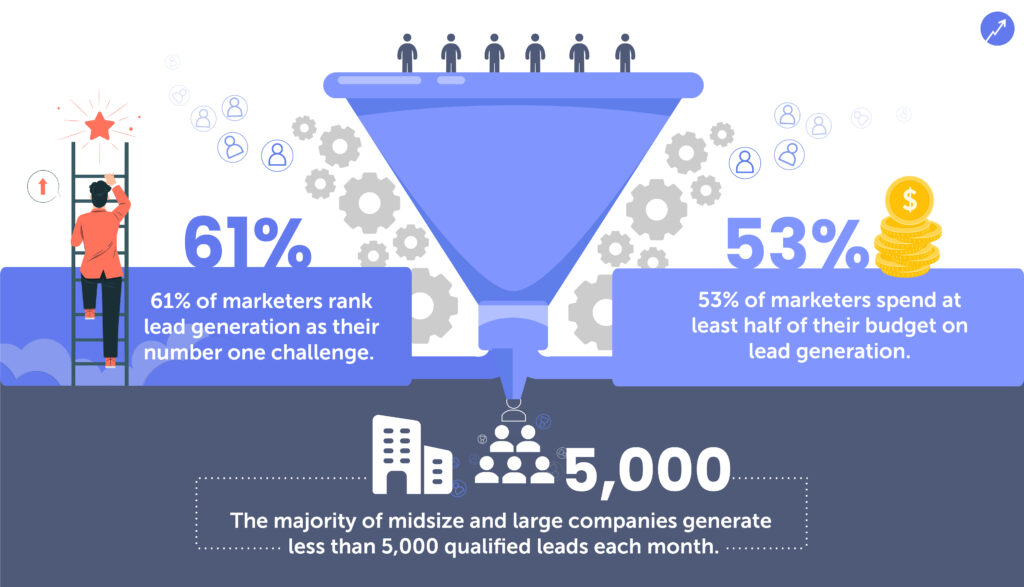B2B lead creation is essential for attracting new prospects interested in what your B2B company has to offer. Every sales funnel depends on leads to scale.

How can you stand out from the crowd when there are so many businesses fighting for sales leads?
To assist you in overcoming the lead gen challenge, we’ve put up this guide to help you plan your approach.
What is B2B Lead Generation
B2B lead generation is the process of identifying and attracting potential customers for a business’s products or services. This is typically done through marketing efforts such as social media, email marketing, and content marketing. The goal of B2B lead generation is to generate interest in a company’s products or services and convert leads into paying customers.
Why is B2B Lead Generation Important?
Lead generation is crucial for businesses as it drives growth and revenue. By generating potential customer leads, companies can expand their customer base and increase sales opportunities. Effective lead generation strategies enable businesses to identify and target individuals who are interested in their products or services. This focus on qualified leads improves conversion rates and allows companies to nurture relationships with prospects, ultimately leading to business growth and success.
B2B lead generation is important for businesses that sell to other businesses for a number of reasons:
- It helps to build a sales pipeline: By generating leads, businesses can build a pool of potential customers to target with their sales efforts. This helps to ensure that there is a constant flow of opportunities coming into the sales pipeline.
- It helps to identify potential customers: B2B lead generation helps businesses to identify potential customers who are interested in their products or services. This allows them to focus their sales efforts on the most promising prospects.
- It helps to establish credibility: By creating informative and educational content, businesses can establish themselves as thought leaders in their industry. This can help to build credibility and trust with potential customers.
- It helps to build relationships: B2B lead generation allows businesses to engage with potential customers and build relationships with them over time. This can help to build trust and establish long-term partnerships.
Why Lead Generation is Important For Business
Lead generation is vital for businesses as it fuels growth and boosts revenue. By capturing potential customers’ information, companies can nurture and convert them into paying clients. Effective lead generation strategies help expand the customer base, increase brand awareness, and enhance sales opportunities. It enables businesses to focus their efforts on qualified prospects, resulting in more efficient marketing and higher conversion rates.
What Are B2B Leads?
B2B leads are potential customers for a business’s products or services that are targeted towards other businesses. These leads are typically identified through various marketing efforts, such as social media, email marketing, and content marketing, and are then contacted and nurtured in an effort to convert them into paying customers. B2B leads are an essential part of the sales process for businesses that sell to other businesses, as they help to build relationships and identify opportunities for sales.
What Are the Benefits of B2B Lead Generation?
There are several benefits to B2B lead generation:
- Increased sales: By generating leads, businesses can increase their sales by targeting potential customers who are interested in their products or services.
- Improved targeting: B2B lead generation allows businesses to target their marketing efforts towards specific groups of potential customers, increasing the chances of success.
- Cost effectiveness: B2B lead generation can be more cost effective than other forms of marketing, as it allows businesses to target their efforts towards a specific group of potential customers.
- Increased brand awareness: By creating informative and educational content, businesses can increase their brand awareness and establish themselves as thought leaders in their industry.
- Improved customer relationships: B2B lead generation allows businesses to build relationships with potential customers over time, increasing the chances of converting them into paying customers.
Who Conducts B2B Lead Generation?
B2B lead generation is typically conducted by marketing teams within businesses that sell products or services to other businesses. These teams may consist of in-house staff or external contractors and agencies, and may also include specialized lead generation firms or agencies. B2B lead generation requires a combination of strategy, creativity, and persistence to be successful.
How is B2B Lead Generation Conducted?
B2B lead generation is typically conducted through a variety of marketing efforts, such as social media, email marketing, content marketing, and search engine optimization (SEO). These efforts aim to generate interest in a business’s products or services and convert leads into paying customers. Effective B2B lead generation requires a combination of strategy, creativity, and persistence, and may include techniques such as creating informative content, running webinars or other educational events, and using social media to engage with potential customers.
We will go over all you need to know about B2B lead generation. Explore how to create B2B leads, maximize your outcomes, learn new techniques for you and your marketing team, and understand the big picture.
The guide includes:
- Follow the Proven B2B Lead Generation Strategy
- Know Your Sales Qualified Leads and Marketing Qualified Leads
- Avoid the Blind Spot During Lead Qualification
- Replace Cold Approach with Data-Driven Lead Generation
- Make Smart Use of LinkedIn for Lead Generation
- Generate Leads from Your Webinars
- Look for Only the Best Tools
Follow the Proven B2B Lead Generation Strategy
According to Forbes, 85% of B2B marketers consider lead generation their first challenge.
No matter how amazing your product or service is, you have to work to get more people to know about it. Quality B2B leads don’t come out of thin air. B2B lead creation is critical to meeting your sales targets, but you don’t want to get hung up strictly on the number of leads. What is more essential is the quality of leads so that salespeople can take ownership, call them, meet with them, and close deals.
Being in the B2B industry for a long time, we have helped a lot of clients with a strong product or a service who lacked brand awareness. When they got enough exposure, the revenue jumped and never came down.
There are tons of articles written on lead generation strategies. However, follow only the proven ones. We have created a collection of 21 proven lead generation strategies for you.
Know Your Sales Qualified Leads and Marketing Qualified Leads
Sales and marketing should work together to define Marketing Qualified Leads (MQL) and Sales Qualified Leads (SQL) for your organization. While your marketing and sales teams may have distinct KPIs and team goals, they are ultimately aiming for the same thing: revenue growth.
Marketing Qualified Leads (MQLs) are the leads who have expressed interest in your offering, participated in your marketing campaign, or are more likely to convert into a customer than other leads.
Sales Qualified Leads (SQLs) are leads that your sales executives have recognized as eligible for direct sales follow-up. Such connections have made direct sales queries or responded to bottom-of-the-funnel offers, such as a free trial.
Given that, generating leads that qualify your MQL and SQL criteria is a challenge for sales and marketing professionals. Following a few valuable tips, modifying your current approach for generating leads can help you overcome this challenge.
Avoid the Blind Spot During Lead Qualification
It is critical to recognize when a lead is ready to be passed on to sales. Companies frequently rely on whether or not the lead fits their ideal client profile. To some extent, this works. But as a result, they have a blind area that leads to incorrect lead qualifying.
If you just consider fit, you’ll know which leads are qualified and if they are ready to speak with salespeople. To completely understand the quality and sales readiness of your leads, your company requires a second lead scoring model. You may already be tracking your leads’ activity through website visits, email clicks, material downloads, and other engagements with your company. This is taken into consideration by behavioral lead scoring. But you won’t get the whole story. You’ll only get a taste of it since you’re only seeing what happens on your own website/materials.
Buyer Intent data assists you in avoiding this blind spot by showing whether a lead is ready to buy or needs more nurturing based on their engagement with different topics across the web. Even if the lead has not progressed all the way through your marketing and sales funnel, you can find warm, engaged leads instead of starting from scratch. Here’s a detailed article that explains how intent data shows you a clear path to qualify your leads.
How to Qualify B2B Leads
To qualify B2B leads, businesses typically use a set of criteria to determine whether a lead is likely to become a paying customer. This may include evaluating the lead’s budget, authority to make purchasing decisions, and level of interest in the business’s products or services. Other factors that may be used to qualify B2B leads include the size of the lead’s organization, the industry they are in, and the fit between the lead’s needs and the business’s products or services. By evaluating leads based on these criteria, businesses can prioritize their efforts and focus on the most promising leads.
Replace Cold Approach with Data-Driven Lead Generation
Not every lead turns into a sales opportunity, especially when sales and marketing are not in sync. For example, a marketing team may bring in more (low-quality) leads and send them to the sales team. The sales staff will become disheartened if they are unable to close them. This is due to both sides’ failure to fully use their data. Data-driven marketers are concerned with qualifying leads and optimizing sales possibilities rather than merely top-of-funnel lead acquisition.
Data is now readily available across organizations and departments. However, according to Forbes, 85% of B2B marketers still view lead generation as a difficulty. The problem most marketers face is how to leverage the data correctly to generate income, beginning with high-quality lead creation.
If you want to dive deeper, here’s an article where we have discussed the right data-driven model for lead generation.
Make Smart Use of LinkedIn for Lead Generation
LinkedIn is the de facto social networking site of choice for B2B lead generation, allowing you to identify and reach out to B2B buyers.
According to a LinkedIn report:
- There are over 630 million business professionals on LinkedIn.
- 100 million of those users are active daily.
- 63 million LinkedIn users are professionals with purchasing power.
However, you cannot just optimize your company page with some basic information, send out a few invites to connect, and expect the magic to happen.
Though LinkedIn allows you to InMail your prospects to start a discussion, there is a limit to how many InMails you may send. You are probably wasting your valuable time if you are making and re-crafting InMails that are not seen. Supplementing your InMail approach with solutions that allow you to export your prospect’s contact information from LinkedIn and contact them by email or phone is a fantastic method to start LinkedIn B2B lead gen.
While LinkedIn is an expensive platform for paid marketing campaigns, there are still tried and tested ways to reach your prospects faster by using LinkedIn as a starting point.
Generate Leads from Your Webinars
According to American Marketing Association research, webinars are used by 60% of marketers as part of their marketing plan. According to a Curata poll, 79% of purchasers are willing to provide their contact information in return for webinar access. However, all of the sales-ready leads do not rush forward at the moment you announce a webinar. Marketers must take a proactive approach to generate leads and sign-ups.
Webinars are a tried-and-true marketing approach that has been shown to produce new sales leads. But only if they are effectively implemented. Here are the top 10 strategies for generating leads from webinars and ensuring that you get the most out of the webinar work you put in.
Look for Only the Best Tools
There are several lead generation resources available to assist everyone in generating more leads and closing more transactions. The only difficulty is sorting through a large number of apps accessible. We spent hours selecting, narrowing down, and testing ten of the top lead-generating tools that you can utilize to grow your business and achieve the numbers in 2021.
You need to consider each type of lead generation tool with the criteria below.
Usability
It should just take a few hours to research and comprehend the lead generation strategy and tool you’ve chosen. Furthermore, it should not be intended to force you to reorganize your whole process.
Implementation Simplicity
You shouldn’t need a developer to get the most out of the tool you picked. This raises a big red flag. The setup should just take a few minutes.
Options for Integration
Another important consideration is whether or not the application is compatible with your marketing stack. Is it going to deliver lead data to your CRM or ESP without a hitch?
Cost
When it comes to purchasing software for your business, the cost is always a consideration. The cost of lead collecting software may be reduced to nothing if you know your ROI.
Identifying the right lead generation tool for your business is like searching for a needle in a haystack. We have listed 10 of the best lead generation tools B2B companies should consider.
Ways To Improve B2B Lead Generation Quality
There are several ways to improve the quality of B2B lead generation:
- Identify your target audience: It’s important to identify the specific group of potential customers that you want to target with your lead generation efforts. This will help to ensure that your marketing efforts are relevant and effective.
- Create compelling content: To attract potential customers, it’s important to create informative and engaging content that addresses their needs and pain points. This can be in the form of blog posts, white papers, ebooks, or webinars.
- Use SEO to optimize your website: By optimizing your website for relevant keywords, you can increase the chances of attracting potential customers through search engines.
- Use social media to engage with potential customers: Social media platforms such as LinkedIn, Twitter, and Facebook can be valuable tools for engaging with potential customers and building relationships with them.
- Utilize email marketing: Email marketing can be an effective way to reach potential customers and nurture them through the sales process.
- Use lead magnets to attract potential customers: Lead magnets are offers such as free trials, demos, or ebooks that are designed to attract potential customers and encourage them to provide their contact information.
- Continuously track and measure your results: It’s important to track and measure the results of your lead generation efforts, so that you can continuously improve and refine your approach. This can be done through tools such as Google Analytics or a CRM system.





